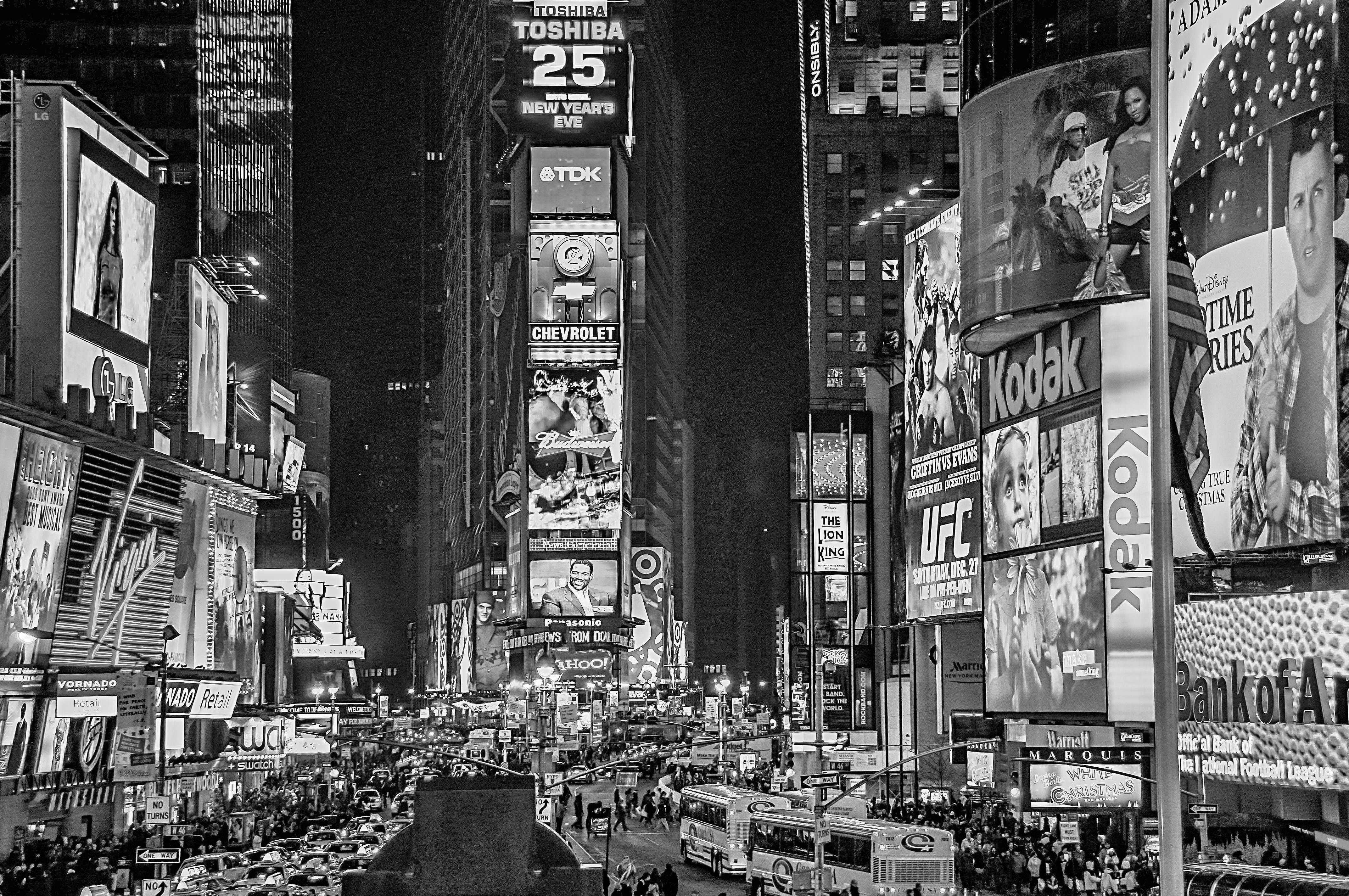The age of advertising must come to an end
Advertisements are a scourge upon society, the environment, and ourselves. They are among the worst capitalism has to offer. Why not get rid of them?
The concept of endless growth is a key ideological component of capitalism. Despite its devastating environmental and social consequences, growth for the sake of growth remains one of the main drivers of the global economy. Without it, the entire system comes crashing down like a gigantic house of cards.
There are several ways in which capitalism seeks to sustain this limitless growth, ranging from the conquest of new markets to the exploitation of nature and labor, the privatization of public goods, and planned obsolescence. Another major method is the artificial creation of previously non-existing needs and desires to extract ever-increasing rents. This is commonly referred to as advertising.
The dawn of the advertising industry
The advertising industry is a global juggernaut that influences everything we do, up to and including our behavior, opinions, preferences, and even our thoughts. Ads are everywhere. There is, quite literally, no getting away from them. On the streets and in public places, on TV, at events, on your phone, and especially on the internet. It hasn’t always been this way.
Only in the last century, and especially in the decades since the fall of the Soviet Union, has the advertising industry grown into this massive all-encompassing behemoth. But, like most monsters, it had humble and even benevolent beginnings.

In the early 20th century, advertisements served a clear purpose: they informed customers about the useful qualities of a product and how that product solved a specific problem or need. People bought what they needed, and they usually bought quality.
This posed a problem, however, as it ran counter to capitalist doctrine and the philosophy of growth. Once people’s needs were fulfilled, they just stopped buying. Sales slowed or even ground to a halt. Yes, people were happy, and their needs were satisfied — but what about the stock price and the shareholders? In a system based on expansion, this seemed an insurmountable problem. Capitalists came up with two solutions: planned obsolescence and a new theory of advertising.
Profit and manipulation
Every few decades or so, capitalism must find new ways to extract rents from the general public. Enclosure, colonialism, slavery, wars, neoliberalism, and privatization are all manifestations of capitalism’s desire to sustain and prolong its existence. While it’s easy (for some) to ignore some of the most horrific and inhumane historical circumstances under which capitalism thrived, there is one thing that no one alive today can ignore: advertisements.
The goal and main purpose of ads is to go beyond the narrow limits of real needs and create new ones that did not exist before. This all started with the curious theories of Edward Bernays, a nephew of the well-known psychoanalyst Sigmund Freud. Bernays was the first to describe the theoretical foundations of manipulating people into consuming far beyond their needs.
One of his ideas was to plant specific anxieties and fears into people’s minds and then present a product as a solution to these fears. Another strategy was to emphasize how a product will elevate one’s social standing or distinguish one from the lower classes, who could not afford to buy the same product. We have all met people who live far beyond their means to appear successful or desirable, while struggling with crippling debt at the same time. In the US, specifically, such behavior is highly encouraged.

Bernays’ ideas have shaped the world and enabled American-style capitalism to spread from its birthplace and take over the world. It’s difficult to overestimate the profound impact this had on all of us — for better or worse.
Ads. Ads, everywhere
A survey conducted in the 1990s revealed some extraordinary facts: 90% of all American CEOs believed that selling a new product without advertisements would be impossible; 85% were convinced that advertisements persuade people into buying things they don’t need, and 51% — a majority — believed that advertisements persuaded people into buying things they don’t even want.¹
Clearly, those in power use advertising as a tool of manipulation, perfected on a grand industrial scale, and now, with the possibilities of the internet, more dangerous than ever before.
Thanks to social media, tailored algorithms, big data, browser cookies, and other technologies, companies are able to target us with never-before-seen precision. Everything we do is used to create increasingly powerful advertisements that target our specific personalities, fears, anxieties, and desires, and manipulate us into buying things that will presumably make us feel better. Multinational giants such as Google (at the time of writing the fourth largest company in the world by market cap) have mastered the art of manipulation; it’s their primary source of revenue and we do not even mind anymore.
In the EU, some ideas are floating around for the regulation of such behavior, but almost nothing concrete has been enacted so far. Even if policies that aim to restrict targeted advertising were to be put into effect, capitalism is bound to find new ways of extracting rents and manipulating consumers. If anything, advertisements are becoming more and more aggressive. As people became accustomed to constantly being bombarded with ads, the industry was forced to develop ever more sophisticated ways of grabbing our attention. There is now a massive war going on to capture every last millisecond of it.

Advertisements are everywhere because they work so frighteningly well. Several studies show that advertising expenditure has a significant impact on material consumption. The industry as a whole is expanding at an incredible rate. Global advertising revenue was estimated to be around $400 billion in 2012; in 2022, that figure rose to $800 billion. It will likely surpass the trillion-dollar mark in 2026.
In 2021 alone the amount of money spent on advertising rose by 16%, with the United States representing the largest advertising market, by far. Spending in the US is roughly three times that of its closest competitor, China. All of this adds up to make advertising one of the world’s largest industries. That seems rather shocking, considering that advertisements themselves do not provide anything inherently useful.
Ads are an inherent part of the neoliberal system of exploitation. Read more about this here:
Planned and perceived obsolescence
We’ve already mentioned planned obsolescence as another tool employed by capitalists to sustain the myth of endless growth and postpone the inevitable collapse of it all. Advertising and planned obsolescence are not mutually exclusive, however. More often, they are employed in tandem.
Apple, the world’s largest company with a market cap of around $2.4 trillion, is a great example for this. Apple’s products are purposefully designed to become obsolete in a matter of years. Anyone who has ever owned an iPhone can attest to the fact that it eventually becomes cumbersome and slow to use. The near-impossibility or prohibitive cost of repairing Apple products, as well as the company’s brilliant marketing (from the point of capitalist growth), contribute to this issue. The newest product is always made to represent a revolution and utter transformation of technology. Of course, in reality, it is anything but.
New Apple products are mostly based upon very marginal improvements, and specific features are sometimes removed only to be reintroduced in a later model. It’s a vicious cycle of electronic waste and represents, in essence, a form of wealth redistribution from consumers to a multinational corporation, i.e. its shareholders. Not to mention the labor that goes into making the products, which is mostly performed in countries of the Global South, where forced-upon neoliberal reforms have kept wages low and working conditions cheap.
In the EU, policies aimed at preventing practices such as impeding repairs or deliberately slowing down devices are gaining traction, but industry leaders are heavily lobbying against them.
Another troubling case of capitalist wastefulness and harm is the the majority of the fashion industry. Clothing is one of those needs that are very easily fulfilled. In societies not based upon endless growth, coats, shirts, pants, shoes, and the like are made to last for many years if not decades. Just ask your grandparents. This, however, again runs counter to the doctrine of growth. The fashion industry had two responses to that:
First, industry leaders jumped aboard the advertisement train, which gained speed in the 1990s. Fashion ads are now purposefully designed to make the clothes we already own appear outdated and inadequate. Every season, companies introduce new fashion lines that are meant to replace the previous ones. This is often referred to as ‘perceived obsolescence.’
The second strategy used by the fashion industry is to create clothes that are designed to fall apart quickly — what is commonly known as ‘fast fashion.’
And it worked.
In the UK, annual expenses on clothing and footwear have been increasing since at least 1986. Following a pandemic-related slump in 2020, when expenditures fell by around 20% as compared to 2019, sales increased by 16.2% in 2021, reaching £57 billion after peaking at £60 billion in 2019. The use of land, water, resources, and labor (again, mostly performed in countries of the Global South) to support the fashion industry has skyrocketed accordingly. With disastrous consequences for the environment.
It’s capitalism, stupid
As one contemplates upon these facts, one has got to wonder: who is to blame for it all? Yes, businesses are pushing the growth agenda and doing everything in their power to maximize profits, but, still, it’s ultimately the consumers — all of us — who enable this behavior. We are being actively manipulated, of course (most of the time, we do not even realize it), but in the end, it’s still our decisions that legitimize actively harmful industry practices and possibly capitalism as a whole. Over the last few centuries, capitalist propaganda has done its homework.
There are lines upon lines of people waiting to buy the new iPhone (or whatever ‘new’ product Apple churns out), scrambling over each other to be the first to hold it in their hands. And most of us are guilty of owning far too many clothes and tossing them away as soon as they seem out of date. Capitalism — and its close cousin consumerism — appear to be deeply ingrained in us now. It’s all most of us have ever known.
‘It’s easier to imagine an end to the world than an end to capitalism.’
Frederic Jameson’s quote (often also attributed to Slavoj Žižek) rings very true.
What can be done?
Most people (with the exception of business leaders and marketing executives, perhaps) will agree that advertising, its tight grip on us, and its manipulative nature are harmful and that something should be done about it. Well, realistically speaking, what can be done? (Except abolishing capitalism altogether, of course, which would be the sensible thing to do, really, in my humble opinion.)
For one, legislators could impose caps on total ad spending or make certain manipulative practices illegal. However, as previously discussed, capitalism will most likely find new ways to compel people into buying its products. Capitalism will find a ‘fix.’ A far more effective policy would be the complete removal of advertisements, both physical and digital, from public spaces.
It’s mostly a conscious decision to look at one’s phone or watch TV. But that choice is taken away when it gets to public places. People have no control over what they see there. Banning unwanted ads from public spaces seems like a comparably uncontroversial thing to do. Several cities, including Paris and Grenoble in France, São Paulo in Brazil, and Chennai in India have taken concrete steps in this direction. In São Paulo, ads are banned from certain parts of the city, and in Paris, they are prohibited near schools.
Several more cities are following suit, with a growing ad-free movement aiming to make cities a better place to live. ‘Adfree Cities,’ a UK-based nonprofit, is one such example. Cities such as Bristol, Birmingham, and Cardiff are part of its network, attempting to drastically reduce the amount of urban advertising. It’s an uphill battle, but one worth fighting for.
Imagine the city as a place where one’s thoughts are not continually interrupted by screaming ads and constant stimulation. Where not every single surface is used to sell something. Things we do not need or even want.
According to studies, reducing advertising has a measurable positive effect on people’s well-being. And we didn’t even mention ad-related mental health problems, sexism and issues of body image, the environmental impact, or light pollution here.
Imagine cities filled with art instead of ads. It’s a nice dream. Yet instead of encouraging the expression of art in public spaces, we label it vandalism and imprison or fine people for it. Graffiti and similar creative expressions are prohibited, while one cannot even look around without being barraged with advertisements.
Our world was built for cars, not people. Read more about this here:
The capitalist point of view
Of course, capitalists will strongly oppose all of this. They will argue that advertisements serve a clear and valuable purpose: they inform us about products, assist us in deciding what to buy, and thus increase market efficiency by promoting the sale of quality products and preventing inferior ones from capturing the market. This claim is, of course, nonsense.
The purpose of ads is not to help us make rational decisions as capitalists are fond to claim, but, on the contrary, to trick us into making irrational ones. The rational decision would be to stop constantly buying new clothes or stop throwing away phones every two years and spending a fortune on new ones. Capitalism manipulates us into making choices that are actively and demonstrably harmful to our environment, society, and ultimately ourselves. It’s all about normalizing actions that we intuitively know are wrong.
The argument that advertisements provide us with information that we would not have otherwise also appears unsubstantiated. This may have been true before the internet, but we no longer need advertisements to stay informed. A quick and easy internet search can provide us with all the information we might require about a particular product. Ads now only serve to bring products to our attention that we would not even look up because we, quite simply, do not need them. We never did.
The advertising industry has overstayed its welcome. It’s high time for us to move beyond and leave it where it’s supposed to be: on the garbage dump of history. Right there with all the waste it produced. A curiosity; a symptom of late-stage capitalism and the madness of our times.
I’m author, writer, and activist Antonio Melonio, the creator of Beneath the Pavement. If you enjoyed this piece, please consider becoming a paid subscriber here on Substack or over on Patreon. It’s the best way to support Beneath the Pavement and help me put out more and higher-quality content.
If monthly contributions are not your thing (I understand), you can also leave me a tip or some coffee money over on PayPal. Thank you.
Sources and further reading
¹Hickel, J. (2022). Less is More — How Degrowth Will Save the World. Penguin Books.
Built Not to Last: How to Overcome Planned Obsolescence | Sierra Club
How Fast Fashion Is Destroying the Planet — The New York Times
Adbusters. https://www.adbusters.org
The growing global movement to end outdoor advertising — Equal Times







Can we start by outlawing legal firms and big pharma from advertising again?
I could not be more on board.